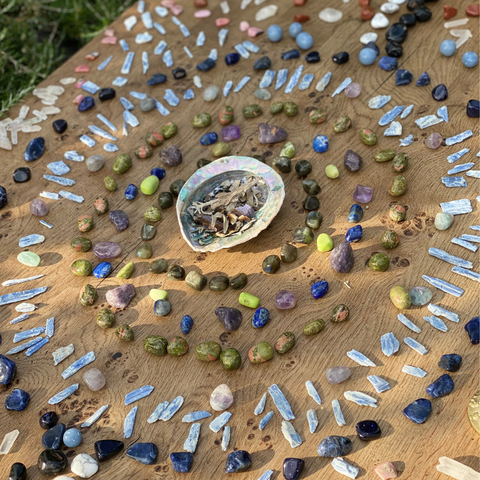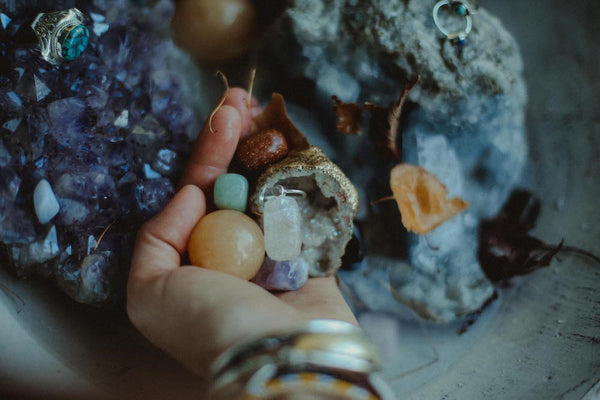Which crystals cannot be charged in moonlight

When it comes to harnessing the power of crystals for healing, meditation, or spiritual practices, many enthusiasts often find themselves asking the question: which crystals cannot be charged in moonlight? The moon is a powerful source of energy, and while some crystals thrive under its gentle glow, others can be adversely affected by lunar energies. Understanding which crystals are sensitive to moonlight can enhance your crystal care routine, ensuring that you maintain their integrity and vibrational frequency.
The Basics of Crystal Charging

Before we delve into the specific crystals that cannot be charged in moonlight, it’s essential to have a foundational understanding of what crystal charging entails. Essentially, charging a crystal involves infusing it with energy to amplify its properties or cleanse any negative vibrations it may have absorbed. This practice can enhance the effectiveness of the stone in various applications, such as healing, manifestation, and protection.
The Role of Moonlight in Crystal Charging

Moonlight holds a special place in the hearts of practitioners. Unlike the intense rays of sunlight, moonlight is softer and carries a serene quality. Many believe that charging crystals in moonlight promotes calmness and emotional healing. For crystals like selenite, moonstone, and amethyst, the moon is an ideal energy source.
However, not all stones benefit from moonlight. In fact, some can experience adverse effects when exposed to lunar energy. This is due to their chemical composition and energetic makeup, which can react negatively to the moon’s influence.
Understanding the Energy of Crystals

Crystals possess unique frequencies and energies, making them suitable for various purposes. They may absorb, reflect, or emit energy based on their structure. When considering which crystals cannot be charged in moonlight, one must take into account the qualities within each mineral.
Some crystals may become dull or lose their natural luster when exposed to moonlight. Others might even change color or become brittle. Thus, understanding the nature of each crystal allows you to effectively utilize their energies without compromising their integrity.
Common Crystals That Cannot Be Charged in Moonlight

After exploring the general principles of crystal charging, let’s now focus on those specific crystals known to be incompatible with moonlight. Below, we will discuss the characteristics of these crystals and explore why they should be kept away from lunar energy.
Black Tourmaline
Black tourmaline is renowned for its protective qualities. It is frequently used to ward off negativity and purify the surrounding environment.
However, this powerful stone can lose its grounding energy when exposed to moonlight.
The reason lies in its high iron content, which reacts poorly to the moon’s energy. Exposing black tourmaline to moonlight may cause it to become less effective at repelling negative energies and may even alter its electromagnetic field.
For those wishing to cleanse or recharge black tourmaline, consider methods other than moonlight, such as smudging with sage or placing it on a bed of salt overnight. These alternatives preserve its potent protective qualities while maintaining its original frequency.
Fluorite

Fluorite is a favorite among crystal users due to its ability to clear mental fog and enhance concentration. It comes in various colors, each with unique attributes.
Yet, exposing fluorite to moonlight can lead to significant fading of its vibrant hues. The subtle light of the moon is inadequate to charge this stone properly; instead, it can wash out its saturation, leading to a loss of vitality.
To ensure that fluorite retains its beautiful colors, it is best to charge it using sunlight, regardless of intensity, for shorter durations. This method preserves its visual appeal while bolstering its clarity-enhancing abilities.
Rose Quartz
Rose quartz is often dubbed the stone of love and compassion. Its soft pink hue radiates feelings of warmth and affection.
However, moonlight can dull its energy over time. The gentle yet pervasive nature of moonlight can strip away the vibrancy of rose quartz, resulting in it becoming less resonant with its loving attributes.
For those looking to amplify the energy of rose quartz, opt for charging it under direct sunlight rather than the moon. This practice ensures that the stone maintains its nurturing properties and remains attuned to one’s heart chakra.
Amethyst
Amethyst is widely celebrated for its calming and protective qualities. Many people use it to promote relaxation and spiritual growth.
Nevertheless, prolonged exposure to moonlight can lead to amethyst losing its deep purple color, turning into a more muted shade. This phenomenon occurs because amethyst contains iron impurities that can bleach out under the moon’s light.
To keep amethyst shining brightly, it’s advisable to charge it during daylight hours, preferably in the sun. This approach helps retain its color while enhancing its soothing vibrational qualities.
Why Some Crystals Are Sensitive to Moonlight

Understanding why certain crystals cannot be charged in moonlight sheds light on the intricate relationship between crystal chemistry and celestial influences.
Chemical Composition and Reactivity
Each crystal has a distinct chemical composition that influences how it interacts with external energies, including light. For instance, minerals rich in iron, such as black tourmaline and amethyst, tend to be more susceptible to changes caused by moonlight. The light’s low energy can destabilize their structures, causing alterations in color and vibrancy.
In contrast, crystals composed primarily of silicates or non-reactive materials, such as quartz, do not typically suffer adverse effects in moonlight. Their stable structures allow them to absorb lunar energy harmoniously, enhancing their vibrational frequency without depleting their essence.
Energetic Frequencies
Beyond their physical makeup, the energetic frequencies of crystals also play a vital role in their compatibility with moonlight. Each stone emits unique frequencies that resonate with external energies differently.
Crystals that are naturally high-energy stones, such as fluorite, may struggle to adapt to the more passive energy of moonlight. This dissonance can lead to diminished efficacy or shifts in their inherent properties.
Conversely, stones that thrive under lunar energy, like selenite and moonstone, are inherently aligned with the moon’s frequencies. Therefore, understanding the energetic properties of different crystals provides insight into how they should be treated during charging rituals.
Best Practices for Crystal Care and Charging

Knowing which crystals cannot be charged in moonlight is just one piece of the puzzle. Proper care and charging techniques can significantly enhance the longevity and effectiveness of your crystals.
Alternative Methods of Charging
While some crystals should avoid moonlight, there are numerous alternative charging methods that can rejuvenate your stones without risking damage.
Consider using:
- Sunlight: Many crystals benefit greatly from sunlight, which can invigorate their energy and restore their vibrant appearances.
- Earth: Placing crystals underground or in soil allows them to absorb Earth’s natural energies, helping to ground and revitalize them.
- Sound: Utilizing sound healing, such as singing bowls or chimes, can help cleanse and recharge the energy of crystals.
- Visualization: Guided visualization while holding your crystal can create a personal energetic connection, infusing it with your intentions and desires.
Cleansing Techniques
Regular cleansing is integral to maintaining the health and effectiveness of crystals. Various cleansing methods exist to suit different stones and personal preferences.
- Smudging: Burning sage or palo santo and wafting the smoke over your crystals can cleanse them of negative energies.
- Saltwater: Submerging non-sensitive stones in saltwater can help cleanse them, but avoid prolonged exposure for those unable to withstand moisture.
- Sound Baths: Sound waves generated by Tibetan singing bowls or tuning forks can energetically cleanse crystals.
- Breathwork: Using intentional breathing techniques while focused on your crystal can help clear any stagnant energy it may have absorbed.
Storing Your Crystals
Proper storage is crucial to protect your crystals from potential damage.
- Avoid Direct Sunlight: While some crystals benefit from sunlight, others can become damaged if left in direct sun for extended periods.
- Silk Pouches: Using silk pouches for storage maintains the integrity of your crystals, preventing scratches and environmental damage.
- Organized Display: Organized displays keep crystals safe and easily accessible, allowing you to connect with them regularly.
FAQs

Which crystals can be charged in moonlight?
Most clear or translucent crystals, such as selenite and moonstone, can safely be charged in moonlight. They are known to harmonize beautifully with lunar energies.
How can I tell if a crystal is damaged from moonlight exposure?
Signs of damage include color fading, dullness, or brittleness. If you notice any of these changes, it may be best to switch to alternative charging methods for your crystals.
Can I use both moonlight and sunlight to charge my crystals?
Yes, many crystals can benefit from both. However, always research the specific needs of each crystal before exposing it to either light source.
How often should I charge my crystals?
Charging frequency depends on individual usage. Regularly using your crystals may require more frequent charging, while those kept for decorative purposes may need less attention.
What happens if a crystal absorbs too much energy?
If a crystal becomes overloaded with energy, it may become unbalanced or less effective. Cleansing and resetting the crystal periodically can help maintain its optimal state.
Conclusion
In conclusion, understanding which crystals cannot be charged in moonlight enables crystal enthusiasts to better care for and harness the energies of their stones. By acknowledging the delicate balance between each crystal’s unique properties and the forces of nature, individuals can cultivate a deeper connection with their crystals. Using alternative charging methods, regular cleansing routines, and proper storage techniques can contribute to the longevity and effectiveness of your beloved gemstones. Embrace the power of crystals mindfully and enjoy the journey of discovery that lies ahead!









